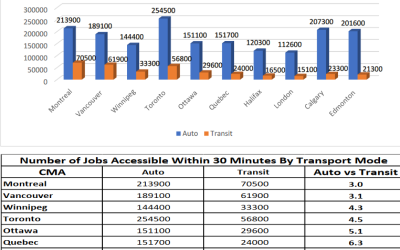Canadians have discovered a cheaper way to fly to the United States: Drive there first.
Rising flight taxes and a strengthening Canadian dollar are pushing Canadians to begin their U.S.-bound trips on U.S. soil. Now airlines are rushing to meet the demand, adding service at small outposts along the border.
Discount carrier Allegiant Travel Co. ALGT +3.47%first stumbled onto the strategy in 2004 when it began service from Bellingham, Wash., a city of 81,000 an hour south of Vancouver. The carrier quickly found that more than half of its passengers were driving there from Canada.
Since then, Allegiant has unlocked a new customer base by filling planes with Canadians at a dozen lower-cost airports strung along the Canadian border.
For the border airports, the Canadian passengers have meant new life. At the three where Canadians make up more than 60% of the passengers—Bellingham, Niagara Falls, N.Y., and Plattsburgh, N.Y.—departing passengers have more than tripled to a total of 750,000 since 2007, and major expansions are planned or under way.
In Plattsburgh, just 60 miles south of Montreal, city officials in 2007 turned the former local Air Force base into an airport and nicknamed it "l'aéroport américain de Montréal." The airport's website and all of its signs are bilingual, and employees are offered French classes.
"We knew it was going to be successful," said Michele Powers of the area chamber of commerce, "but we had no idea it was going to grow this quickly." Passenger traffic has tripled since 2008, and officials are now planning to double the size of the terminal just five years after its opening.
Taxes and fees on a flight from Canada to U.S. cities can be four times higher, or nearly $100 more each way, than on flights to the same destinations from U.S. airports located just miles across the border. Canadian airlines say that gap has made it nearly impossible to compete.
The tax-and-fee gap between the two countries is the result of differing governing philosophies.
Canada views air travel as best paid for by fliers themselves, requiring them to fund airports' capital projects, said Daniel-Robert Gooch, president of the Canadian Airports Council.
That strategy has made Canada home to some of the best aviation infrastructure in the world without burdening Canadian taxpayers as a whole, he said.
The U.S., however, subsidizes many airports, especially in rural areas, betting they can drive economic activity.
Canadian airports and airlines, meanwhile, are trying to plug the passenger leak. They recently commissioned studies on the exodus to lobby the Canadian government to lower taxes on flying.
They found that U.S. airports near the border handled roughly 4.8 million Canadians departing or arriving last year—15% more than 2010, when it was first tracked. That is enough passengers to fill 64 Boeing Co. 747s per day, or more traffic than Ottawa International Airport, Canada's sixth-largest airport.
"Everyone in Quebec is talking about how airline tickets are (less expensive) here" in the U.S., said Caroline Gallant. The Canadian woman made the 2½ hour drive to the airport in Burlington, Vt. because the $400 round-trip flight to Chicago was half the fare from Montreal, which is 20 minutes from her home.
Friends told her about the Burlington, Vt. airport a year ago, and she has flown from it three times since. "I know it isn't good for our airports, but they should decrease the tax, what can I say?"
On Tuesday, a Canadian Senate committee released a study on the migration, urging the government to stop charging local airport-operating authorities rent for airport land, and to lower taxes on flying, such as a fee to use the country's navigation system that can run as high as 20 Canadian dollars (US$19.50).
"Our position is blown out of the water by all the taxes and fees," said Gregg Saretsky, chief executive of WestJet Airlines Ltd., Canada's largest discount carrier. If every Canadian who drove to the U.S. for a flight last year instead flew from Canada, Mr. Saretsky said WestJet's $149 million net profit would have increased by roughly half.
"But this isn't just a question for the airlines; it is a question for the whole Canadian economy."
Canadian airport officials estimate the preflight migration costs the country nearly 9,000 jobs and $1.1 billion in gross domestic product a year. They also say there are also countless Americans who fly to U.S. border airports and then drive to Canada to save on fares.
On Wednesday, instead of flying directly to Montreal to visit his parents, Jean-Francois Brossoit and his family flew from their home in Indianapolis to Burlington, and then rented a car and drove to Canada, saving them hundreds of dollars.
In the past two years, Canada and the U.S. have raised taxes by about $10 on flights south across the border.
But more increases have come from individual Canadian airports which, unlike those in the U.S., rarely receive government funding and must rely on passenger fees for capital projects. In Calgary, for example, one fee on fliers is increasing to $30 from $20 to pay for a new $1 billion runway.
In the U.S., however, the federal government is paying for a new runway at the airport in Niagara Falls, N.Y., where workers say they count, on average, eight Canadian license plates out of every 10 cars in the parking lot.
The Canadian dollar has also remained largely on par with the U.S. dollar over the past two years, up from about 65 to 80 U.S. cents in the early 2000s.
By all accounts, these factors have driven more Canadians across the border to fly. Airport officials in Buffalo have tracked the trend longest and found that, while overall traffic rose by 3%, the percentage of passengers there that drove from Canada has increased this year to 45% from 26% in 2006.
While overall air traffic in the U.S. has fluctuated over the past decade, passengers have surged at border airports, including those in Grand Forks, N.D.; Great Falls, Mont.; Bangor, Maine; and Burlington. Since Allegiant entered Bellingham in 2004, traffic has increased fivefold there, and the airport now serves 10 destinations, up from one.
Las Vegas-based Allegiant has pioneered the near-Canada routes without entering the country.
Its advertisements cover subway cars in Vancouver and outfield walls at baseball fields in Thunder Bay, Ontario. Other airlines have followed Allegiant's path, such as Spirit Airlines Inc. SAVE +3.46%
Ben Baldanza, Spirit's chief executive, admits the airline is chasing Canadians in those markets. Flights are regularly full, often with Canadians.
On Spirit's inaugural flight from Plattsburgh, passengers didn't budge when the gate agent asked them to begin boarding. "Then she said it in French," said Sonia Cruz, a Spirit director of airport services, "and everyone lined up."


